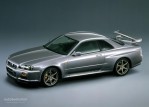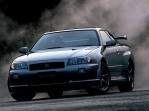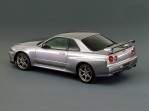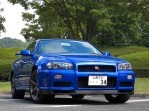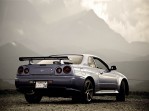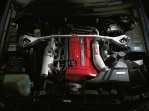Body style: Coupé (two-door)
Segment: Coupe
Production years: 1999, 2000, 2001, 2002
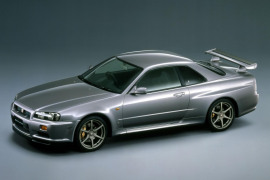 10 Photos
10 PhotosArguably one of the most iconic Japanese sports cars of all time, the Nissan Skyline GT-R R34 has gathered a cult following worldwide. It encompasses 40 years of automotive development, and it's only getting more popular 30 years after production ended.
Ten years before Nissan introduced the R34, its predecessor, the R32 GT-R, had already gotten the nickname of Godzilla, and rightly so. It was the beginning of a golden age for Japanese sports cars, and GT-Rs could take on and even outpace most European and American rivals. Compared to the R32 and R33 GT-Rs, the R34 had a shorter production window. That also means there are fewer of them around. Nissan sold over 64,000 Skylines between 1998 to 2001, but only a small fraction of those were worthy of the Godzilla nickname.
Between 1999 to 2002, 11,578 GT-Rs left the factory in Musashimurayama. Nineteen of those cars would return to Nissan for a special upgrade, but we'll talk about that in a minute. There are over a dozen variations of the R34 GT-R, including Series 1, Series 2, V-Spec, and M-Spec models. Some were more brutal than others featuring several weight reduction upgrades and more, and there's also a difference in production numbers. Finding a V-Spec II isn't exactly a walk in the park, with 1,855 units built in total.
But getting a V-Spec II N1 is about 100 times more difficult. Nissan even made two models to celebrate the car's connection with the Nurburgring race track, where it had undergone extensive testing. Codename V-Spec II Nur and M-Spec Nur, the Japanese manufacturer, built these cars for those who wanted to go either sprint or endurance racing.
A product of a bygone era, all R34 GT-Rs featured six-speed manual transmissions, which became a thing of the past with the launch of the R35 GT-R. Unlike the more entry-level Skylines, the BNR34 benefitted from AWD and a fancy system at that. The ATTESA (Advanced Total Traction Engineering System for All-Terrain) ET-S Pro featured torque-splitting capabilities that could make even an average driver feel like a pro. With AWD, the R34 GT-R was nowhere near as light as a Mazda RX-7, for instance, weighing over 3,400 lbs (1,542 kg).
But at its core was something that made that extra weight redundant: the RB26DETT. Nissan had first used this 2.6-liter, twin-turbocharged, inline-six powerplant over a decade before introducing the R34. Of course, plenty of refinements and upgrades came along in time, with each generation even more potent than the previous one.
The last "Godzilla" of the 20th century featured upgraded ball-bearing turbos, providing phenomenal throttle response in an age where most boosted cars struggled with turbo-lag. The GT-R had a maximum theoretical output of 276 horsepower with the Japanese Gentlemen Agreement. But several independent tests have often claimed that the figure was somewhere north of 320 horsepower instead. With forged pistons and a cast iron block, the tuning potential for the RB26DETT is phenomenal.
Reportedly, you can safely upgrade it to 500 or even 600 horsepower without worrying about complete engine failure. Of course, it doesn't have to end there, and some users have quoted upgrades of around $20,000 to reach 1,000 horsepower with the R34 GT-R. But most Godzilla enthusiasts will tell you that the ultimate model came out of the Omori factory almost 20 years ago.
Nineteen cars were brought in for a particular host of upgrades that took performance levels up to 493 horsepower and 398 lb-ft (540 Nm) of torque. The Nismo Z-Tune is undoubtedly one of the most amazing GT-Rs of all time, as Nissan imbued it with technology derived from their GT500 and LeMans GT2 cars. The RB26DETT was now an RB28 with upgraded turbos and could launch the Z-Tune from a standstill to 62 mph (100 kph) in 3.8 seconds.
Meanwhile, Wangan worshippers were even more excited to learn that it had a top speed of 203 mph (327 kph). All this happened in 2003 when a 911 Turbo S would top out at 197 mph (317 kph). But few people will ever drive, let alone own a Z-Tune, with prices now in the seven-figure range, similar to most iconic supercars that are 20 years old. That's not to say that a regular R34 GT-R is cheap by any means, as prices have been soaring in recent years, and there's no sign of change for the future.
Although this is an unofficial result, it is said that the R34 GT-R lapped the Nurburgring Nordschleife in seven minutes and 52 seconds, with Kazuo Shimizu behind the wheel. If you can finish a lap around the North Loop in less than eight minutes today, you can consider yourself a fast driver. But achieving that result more than 20 years ago must have been phenomenal.
Just look at it this way: that same year, a Ferrari 360 Modena needed eight minutes and nine seconds for the whole lap. A Porsche 911 Turbo was four seconds slower than the R34 GT-R one year later. And in 2014, one famous journalist lapped the Nordchsleife in a BMW M4 at the same time that Nissan's creation did a decade and a half earlier. The R34 GT-R can boast many more motorsport achievements. And a deep dive into the All Japan Touring Car Championship would reveal some impressive results in the GT500 class, culminating with Masashi Motoyama's title in 2003.
NISSAN Skyline GT-R (R34) 1999, 2000, 2001, 2002
- 2.6 TT 6MT (280 HP)
NISSAN Skyline GT-R (R34)
2.6 TT 6MT (280 HP)
ENGINE SPECS - 2.6 TT 6MT (280 HP) | |
|---|---|
| Cylinders: | L6 |
| Displacement: | 2568 cm3 |
| Power: | 206 KW @ 6800 RPM 280 HP @ 6800 RPM 276 BHP @ 6800 RPM |
| Torque: | 293 lb-ft @ 4400 RPM 397 Nm @ 4400 RPM |
| Fuel System: | Turbocharged Multipoint Injection |
| Fuel: | Gasoline |
PERFORMANCE SPECS | |
|---|---|
| Top Speed: | 155 mph (249 km/h) |
| Acceleration 0-62 Mph (0-100 kph): | 4.9 s |
TRANSMISSION SPECS | |
|---|---|
| Drive Type: | All Wheel Drive |
| Gearbox: | 6-speed manual (Getrag 233) |
BRAKES SPECS | |
|---|---|
| Front: | Ventilated Discs |
| Rear: | Ventilated Discs |
TIRES SPECS | |
|---|---|
| Tire Size: | 245/40 ZR18 |
DIMENSIONS | |
|---|---|
| Length: | 181.1 in (4600 mm) |
| Width: | 70.3 in (1786 mm) |
| Height: | 53.5 in (1359 mm) |
| Front/rear Track: | 58.3/58.7 in (1,481/1,491 mm) |
| Wheelbase: | 104.9 in (2664 mm) |
| Ground Clearance: | 5.7 in (145 mm) |
| Cargo Volume: | 6.4 cuFT (181 L) |
| Aerodynamics (Cd): | 0.33 |
WEIGHT SPECS | |
|---|---|
| Unladen Weight: | 3395 lbs (1540 kg) |
| Gross Weight Limit: | 3715 lbs (1685 kg) |
FUEL ECONOMY (NEDC) | |
|---|---|
| City: | 14.7 mpg US (16 L/100Km) |
| Highway: | 26.1 mpg US (9 L/100Km) |
| Combined: | 19.1 mpg US (12.3 L/100Km) |
| Notes |
|---|
| Engine: twin-turbocharged RB26DETT I6 Actual engine power was 246 kW / 334 HP / 330 BHP, but was understated officially, due to legal reasons. |


